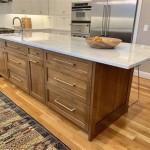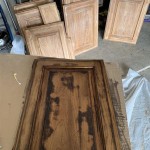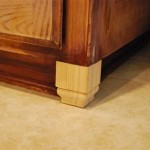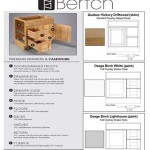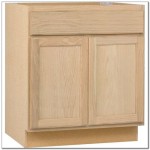What Color Paint for Kitchen with Oak Cabinets?
Selecting the right paint color for a kitchen with oak cabinets can significantly impact the overall aesthetic and atmosphere of the space. Oak cabinets, known for their warm, golden tones and distinctive grain patterns, present unique considerations when choosing a complementary paint color. The inherent warmth of oak can either be enhanced or balanced depending on the desired outcome. Understanding the undertones of oak, the existing elements in the kitchen, and the desired mood are crucial steps in this decision-making process. This article explores various paint color options, providing insights and considerations to help homeowners make informed choices.
Understanding Oak’s Undertones
Oak cabinets typically exhibit warm undertones, often showcasing shades of yellow, orange, or even red. These undertones are inherent to the wood and become more pronounced with certain finishes and lighting. Before even considering paint colors, it is essential to accurately identify the predominant undertones in the existing oak cabinets. This observation serves as the foundation for selecting paint colors that either harmonize with or contrast against the oak, creating the desired visual effect. For instance, if the oak has strong yellow undertones, choosing a paint color with similar undertones can create a cohesive and warm atmosphere. Conversely, opting for cooler tones like blues or greens can provide a refreshing contrast, mitigating some of the warmth of the oak.
Natural light also plays a significant role in how oak cabinets appear. In kitchens with ample natural light, the warm tones of oak might be amplified. In kitchens with limited natural light, the oak may appear darker and more subdued. Therefore, it is crucial to assess the room's lighting conditions during different times of the day to accurately determine the oak's true undertones and how those tones will interact with various paint colors. Artificial lighting, such as under-cabinet lighting or recessed lighting, can also affect the appearance of the oak. Consider the type and intensity of artificial lighting used in the kitchen when making paint color selections.
Beyond the undertones of the oak itself, the existing stain or finish on the cabinets will also impact how paint colors are perceived. A glossy finish will reflect more light, potentially amplifying the perceived warmth of the oak, while a matte finish will absorb more light, creating a more subdued appearance. The age of the cabinets and any previous treatments applied to the wood can also influence its color and undertones. Over time, oak can naturally darken or yellow, so it's important to consider the current state of the cabinets when selecting paint colors.
Exploring Complementary Paint Color Palettes
Once the undertones of the oak cabinets have been identified, the next step involves exploring complementary paint color palettes that align with the desired aesthetic. There are several approaches to consider, each offering a distinct visual effect. Neutral colors, such as whites, grays, and creams, are popular choices for kitchens with oak cabinets, as they provide a versatile backdrop that allows the wood to stand out. However, even within the neutral spectrum, variations in undertones can significantly impact the overall look.
Whites, for instance, can range from warm off-whites to cool bright whites. Warm whites, such as those with creamy or yellowish undertones, can create a harmonious and inviting atmosphere, complementing the warmth of the oak. Cool whites, on the other hand, can provide a brighter, more modern look, creating a subtle contrast with the oak. When selecting a white paint color, it's important to consider the overall color scheme of the kitchen and the desired level of contrast. Testing paint samples under different lighting conditions is essential to ensure that the chosen white complements the oak cabinets and other elements in the space.
Grays offer another versatile neutral option for kitchens with oak cabinets. Similar to whites, grays come in a variety of undertones, ranging from warm grays with beige or brown undertones to cool grays with blue or green undertones. Warm grays can create a cozy and inviting atmosphere, while cool grays can provide a more modern and sophisticated look. When using gray, it's essential to carefully consider the undertones to ensure they complement the oak cabinets and other elements in the kitchen. A warm gray with subtle beige undertones can be an excellent choice for creating a cohesive and balanced look with oak cabinets.
Beyond neutrals, colors can also be effective in balancing the warmth of oak cabinets. Blues and greens, for example, offer a refreshing contrast that can create a more modern and stylish look. Lighter shades of blue, such as pale blues or soft teals, can evoke a sense of tranquility and openness, while darker shades of blue, such as navy or deep teal, can add drama and sophistication. Similarly, lighter shades of green, such as sage green or mint green, can create a calming and natural atmosphere, while darker shades of green, such as forest green or emerald green, can add depth and richness. These color choices help reduce the prominence of the yellow in the oak.
Ultimately, the selection of paint colors depends on the homeowner's personal preferences and the desired aesthetic. There is no one-size-fits-all solution, and it's essential to experiment with different colors and combinations to find what works best for the specific kitchen space.
Considering Other Kitchen Elements
The selection of paint color for a kitchen with oak cabinets should not be made in isolation. It is essential to consider the impact of other existing elements in the space, such as countertops, flooring, backsplash, and appliances. These elements contribute to the overall color scheme and cohesiveness of the kitchen, and the paint color should complement and enhance them.
Countertops, for instance, can significantly influence the choice of paint color. If the countertops are a neutral color, such as white quartz or granite, they provide a versatile backdrop that allows for greater flexibility in paint color selection. However, if the countertops have strong colors or patterns, it's important to choose a paint color that complements them without clashing or overpowering the space. For example, if the countertops are a warm-toned granite with flecks of brown and beige, a warm white or light beige paint color can create a cohesive and harmonious look.
Flooring is another critical element to consider. The color and material of the flooring can significantly impact the overall feel of the kitchen. If the flooring is a cool-toned tile or hardwood, a warm paint color can help balance the coolness and create a more inviting atmosphere. Conversely, if the flooring is a warm-toned wood or tile, a cooler paint color can provide a refreshing contrast and prevent the space from feeling overly warm. Additionally, the texture and pattern of the flooring can also influence the choice of paint color. A heavily patterned floor may benefit from a simpler, more neutral paint color, while a more neutral floor can handle a bolder or more colorful paint choice.
The backsplash is another area that can contribute to the overall color scheme of the kitchen. A neutral backsplash, such as white subway tile, provides a versatile backdrop that allows for greater flexibility in paint color selection. However, if the backsplash features a colorful or patterned design, it's important to choose a paint color that complements it without clashing. Consider pulling a subtle color from the backsplash tile and using it as the primary paint color or as an accent color. The backsplash can be used to introduce pops of color that tie together the oak cabinets and the surrounding elements.
Appliances, too, contribute to the overall look of the kitchen. Stainless steel appliances are a common choice and generally work well with a variety of paint colors. However, if the appliances are a different color, such as black or white, it's important to consider how they will interact with the chosen paint color. Black appliances can create a dramatic contrast with lighter paint colors, while white appliances can blend seamlessly with white or light-colored walls. The finish of the appliances (e.g., matte or glossy) can also influence the perception of the paint color.
Finally, consider the existing hardware on the oak cabinets. Are they brass, chrome, or black? The hardware finish should complement both the cabinet color and the paint color. For example, brass hardware might look best with warmer paint tones, while chrome hardware may work well with cooler tones. Replacing the hardware is also an option if the current hardware clashes with the desired paint color and overall aesthetic.

Paint Colors To Go With Honey Oak Trim Cabinets West Magnolia Charm

Model Kitchen With Oak Cabinets Like The Paint Color Looking For Schemes A Possible New Inspirations Wall Colors

Color Palette To Go With Oak Kitchen Cabinet Line For Those Paint Colors Living Room

5 Top Wall Colors For Kitchens With Oak Cabinets Kitchen

The Best Kitchen Paint Colors With Honey Oak Cabinets And Trim Lantern Lane Designs

Popular Farmhouse Kitchen Paint Colors That Go With Oak Cabinets Simply Diy Home

11 Most Fabulous Kitchen Paint Colors With Oak Cabinets Combinations You Must Know Honey Eclectic Modern

What Kitchen Color Schemes Work With Oak Cabinets The Homes I Have Made

How To Update Oak Kitchen Without Painting Cabinets Hometalk

Paint Colors That Go With Oak Cabinets Julie Blanner
Related Posts

